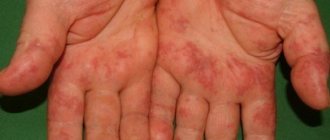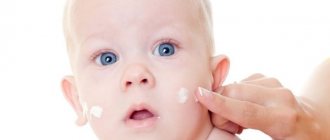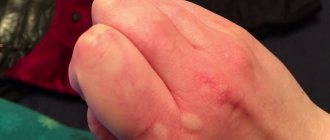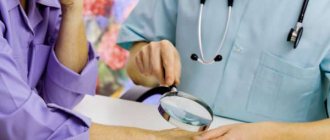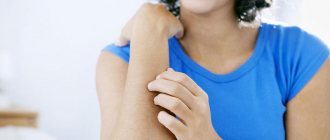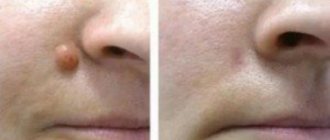Dermatovenerologist
Khasanova
Alina Rashidovna
7 years experience
Make an appointment
One of the forms of vasculitis that develops as a result of an allergic reaction of the body is erythema nodosum. This is the name for inflammation of the blood vessels that penetrate the epidermis, as a result of which painful pink or bluish nodules form in the dermis and subcutaneous fatty tissue. Vascular damage is local in nature and is limited mainly to the lower extremities.
Causes of development of pathology of the lower extremities
Erythema occurs 3-6 times more often in women than in men. It strikes at any age, but is usually seen between the second and fourth decades of life. During this period, the prevalence of sarcoidosis, streptococcal and other infections is highest. In pubertal age groups, the prevalence of the disease is the same among boys and girls.
Inflammation occurs in the subcutaneous layer of fat, causing the formation of red round lumps and nodules that are tender to the touch. The place of their distribution is both legs. Erythema nodosum of the lower extremities, the causes of which are still unknown, is caused by an increased reaction of the immune system to a certain irritant.
The most common triggers:
- pregnancy;
- sarcoidosis;
- rheumatological diseases;
- infections;
- inflammatory bowel diseases;
- autoimmune disorders;
- malignant neoplasms;
- medications.
According to the classification, erythema is divided into idiopathic, which occurs for no apparent reason or internal prerequisites, and secondary, which can be a sign of a serious disease.
Predisposing factors are congestion in the lower extremities, prolonged hypothermia, hypovitaminosis of vitamins C and P, and endocrine disorders. The disease develops mostly in the autumn and spring periods.
Non-infectious causes
Erythema nodosum of the lower extremities, the causes of which are not associated with infections, can occur under the influence of:
- Medicines: antibiotics, penicillins, sulfonamides.
- Oral contraceptives.
- Inflammatory bowel diseases.
- Pregnancy.
- Certain types of cancer, including lymphoma, leukemia.
- Other diseases: celiac disease, lupus erythematosus, ulcerative colitis, reactive arthritis, nephropathy.
Infectious causes
Among the causes of erythema, streptococcal infections are in first place. Many other reasons have been identified, including:
Bacterial:
- tuberculosis;
Erythema nodosum of the lower extremities can be caused by tuberculosis. - syphilis;
- chlamydia;
- brucellosis;
- yersiniosis.
Viral:
- Infectious mononucleosis;
- hepatitis C, B;
- HIV;
- herpes simplex virus.
Fungal:
- histoplasmosis;
- blastomycosis.
Parasitic:
- amoebiasis;
- Giardiasis
The most effective means
Many patients ask what the most effective means are to get rid of the disease forever. Answering this question, I would like to immediately note that there is definitely no suitable medicine for everyone, since its appearance is associated with a number of other current pathologies.
People are chasing expensive drugs in the hope that the pathology will disappear forever. But price and quality do not always coincide. Therefore, remember that a patient can get rid of this disease for pennies at current prices.
Among the medications frequently used by medical practitioners, the following list of drugs has proven particularly effective:
- Prednisolone;
- Dimexide;
- Celandine grass;
- Amoxiclav;
- Claritin;
- Indomethacin.
All these medications are freely available in pharmacies and are not expensive. The dosage and duration of administration should be determined only by a doctor.
Since only he, having found out the cause of the erythema, can accurately determine the need to take the drug. And the senseless consumption of any medications has never brought additional benefit to anyone.
Forms and symptoms of the disease
The disease varies according to the presence of an etiological factor:
- primary stage, when the underlying disease has not yet been clarified;
- secondary stage, in which the disease that caused the erythema is determined;
According to the severity of the disease, erythema occurs in acute, subacute, and chronic forms.
Nodules that appear on the surface of the skin go through their stages of development:
- First stage, maturation. It is characterized by a moderately painful condition, pink in color, without clear boundaries, and develops over 4-7 days.
- Mature or developed stage . It is characterized by nodes that are bright red, painful, have clear boundaries, and swelling of the surrounding tissues. All symptoms continue for 10-12 days after illness.
- Permissive stage . The color range develops to blue-yellow, the pain goes away, the density loses its boundaries, the duration of the stage is up to 14 days.
Based on the course of the disease, severity, and duration of the inflammatory process, 3 types of erythema nodosum are distinguished: acute form, migratory, chronic.
Acute erythema nodosum
Erythema nodosum of the lower extremities, the causes of which are often associated with chronic infections and intoxications, can occur as an acute inflammatory process. In this case, the disease is characterized by the rapid development of painful, bright red, swollen nodes.
Large formations, the size of a walnut, protrude on the surface of the legs in a symmetrical arrangement, less often on the thighs and forearms. The nodes rise above the surface, they do not have clear boundaries, but they do not merge with each other and do not form ulcers. Subsequently, the nodes change color, first acquiring a blue color, and then turning into a greenish and yellowish tint.
The color change resembles a “bruise bloom.” Associated symptoms: fever, sometimes up to 39˚C, headache, weakness, joint pain.
The appearance of nodes is preceded by diseases:
- streptococcal tonsillitis;
- pharyngitis;
- viral infections.
After treatment of the underlying disease, nodular formations disappear after 4-6 weeks. A repeat process is not observed, no scarring remains on the tissue.
Migratory form
This form is a group of several clinical varieties, takes on the character of an acute and subacute process, and there is no asymmetrical appearance of plaques on the legs. First, a single dense knot appears on one shin. Then the color of the skin over the node changes, it becomes bluish-red.
Due to the inflammatory process, a ring-shaped plaque is formed with a pale, sunken center and a wide peripheral zone of saturated color. During this period, small nodules may appear both around the main node and on the other leg. Additional symptoms: chills, joint pain, weakness. The disease lasts from several weeks to several months.
Chronic form
The chronic course of the disease occurs in middle-aged and elderly women; it is characterized by a persistent recurrent nature. Appears against the background of frequent prolonged infections, inflammations or tumors in the pelvic organs, and vascular inflammatory diseases.
Nodes, the size of a walnut, spread on the anterolateral part of the lower leg; they have moderate pain and swelling.
In the initial period, the color of the skin does not change, the nodes do not rise, and they can only be determined by palpation. The course of the disease is associated with seasonal periods, exacerbations begin in autumn and spring. Nodes replace each other all the time, some dissolve, new ones arise.
Forecast
If you go to the hospital in a timely manner and after treatment, a complete recovery most often occurs, and the patient is no longer bothered by the disease, and no traces of the rash remain. Erythema itself is not dangerous; the diseases that accompany it are dangerous, so it is necessary and preferably to consult a doctor as soon as the first signs of the disease are detected. The initial examination for this disease is carried out by dermatologists, you can also contact a therapist, and a general practitioner will refer you to the right specialist.
Features of the course and danger of the disease
The appearance of erythema is preceded by a period during which a person feels extremely weak, quickly gets tired, fever, swelling in the joints, pain, and stiffness appear. Symptoms often resemble those of the onset of influenza. Pain in the legs and joints continues for some time after the rash.
Erythema manifests itself as sudden rashes. If the course is acute, it is accompanied by fever, abdominal pain, vomiting, and diarrhea. Nodules appear symmetrically on the legs, in the anterolateral part. In rare cases, they spread over the surface of the arms, neck, and shoulders.
Externally, the nodules are soft, warm thickenings, from 1 to 5 cm in diameter. At first they have a bright red color, and then change it to blue-yellow. The boundaries of the nodes are unclear because the surrounding tissue is swollen. The nodes may be painful upon palpation. The rashes remain on the skin for several weeks or months, then the nodules heal without atrophy or scars.
In children
Erythema nodosum in childhood is acute. It is characterized by painful rashes that appear on the lower extremities, in the area of the legs, which can merge with each other.
Cause:
- reaction to tuberculosis;
- streptococcal infection of the upper respiratory tract.
- reaction to antibiotics, sulfonamides.
The course of the disease is accompanied by symptoms:
- pain in muscles and joints;
- feeling overwhelmed;
- heat;
In adults
Currently, the leading cause of erythema in adults is sarcoidosis. The frequency of occurrence is up to 65% in various regions. Erythema nodosum is often combined with joint damage.
Other symptoms accompanying erythema developing against the background of sarcoidosis:
- severe swelling of the lower extremities;
- arthralgia of the ankle joints
- large size of nodules, their fusion;
- cough, chest pain, shortness of breath.
Common causes of the syndrome are inflammatory bowel diseases and the use of medications. Tuberculosis is not currently a common cause of erythema nodosum.
During pregnancy
During gestation, when a restructuring of the endocrine-immune cascade occurs, women carrying a child may develop erythema nodosum. This occurs in 8% of pregnant women. During this period, it is extremely important to be promptly examined for infectious markers. The presence of herpes simplex viruses, mycoplasmosis, and chlamydia contributes to the development of erythema syndrome.
What does eczema look like?
The name of the disease refers to the Greek term ekzeo - to boil. This most accurately describes the external and internal nature of the health condition when symptoms are detected.
Acute signs of the disease create a feeling that the skin is “boiling”, this is expressed as follows:
- unbearable itching occurs;
- burning;
- the affected area becomes very red;
- small bubbles filled with liquid (serous exudate) appear in the lesion;
- locally, the skin undergoes pathomorphological changes: it thickens, cracks, becomes very dry, and flakes;
- papules are grouped and slightly resemble bubbles of boiling liquid, which quickly burst, leaving deep wounds - wells or pinpoint erosions;
- the disease proceeds in waves, so over time one can observe old “wells” and fresh vesicles in one focus;
- eczema is a disease characterized by long-term presence and frequent seasonal relapses;
- the disease appears in both children and adults;
- General health affects the likelihood of exacerbation and the frequency of recurrence.
Diagnostics
The diagnosis is determined by clinical manifestations, but other studies are also prescribed to confirm it:
- biopsy;
- skin tests;
- chest x-ray;
- general blood and urine analysis;
- throat swab;
- Ultrasound of internal organs.
Differential diagnostics are carried out to exclude diseases:
- extrapulmonary tuberculosis;
- panniculitis;
- lipogranuloma;
- nodular vasculitis;
- migratory thrombophlebitis;
- skin calcification;
- insect bites;
- acute urticaria.
Treatment of erythema nodosum
Erythema nodosum of the lower extremities, the causes of which are of decisive importance for treatment, involves the use of drug therapy prescribed according to a specific scheme.
To achieve a positive result, doctors set 2 goals: achieving remission and improving the patient’s quality of life. In most cases, bed rest is prescribed, the lower limbs should be elevated, and warm compresses are prescribed.
Treatment of secondary erythema is aimed at eliminating the underlying disease. Potassium iodide, 300-500 mg orally, 3 times daily, is suggested to reduce inflammation. Systemic glucocorticoids are prescribed as a last resort because they may worsen the symptoms of the underlying disease.
Pharmaceutical drugs against erythema nodosum
Erythema nodosum and its treatment include anti-inflammatory drugs, oral or topical corticosteroids. Sometimes doctors prescribe the alkaloid Colchicine to reduce the inflammatory process in the skin of the lower extremities. Therapy must be adapted to a specific person, taking into account all existing causes of the disease.
Non-steroidal anti-inflammatory drugs are prescribed first. The treatment regimen depends on the stage of the disease and the diagnosis of the underlying disease.
| Drug groups | Name |
| NSAIDs | Indomethacin Voltaren Meditol Xanthinol nicotinate |
| Antibiotics | Erythromycin Tseporin Penicillin Doxycycline Amoxiclav |
| Salicylates | Aspirin Askofen |
| Angioprotectors | Aescusan Trental Complamine |
| Anticoagulants | Heparin |
| Vitamins | Askorutin Sinkumar Rutin S, V, RR |
| Glucocorticosteroid (if previous drugs are ineffective) | Prednisolone |
When treating pregnant women in the 1st trimester, local therapy is prescribed, consisting of applications with a 33% solution of Dimethyl sulfoxide, Nimesulide. In the 2nd trimester, NSAIDs and local therapy in the form of lotions are prescribed. Prescription of drugs and doses must be strictly agreed with the doctor.
Ointments for erythema nodosum
For local treatment, absorbable, anti-inflammatory drugs and drugs that have a microcirculatory effect on the vessels are used.
Compresses are prescribed:
- Dibunol liniment, 5%;
- ichthyol solution, 10%;
For applications, medications are prescribed: 33% solution of Dimexide, Nimesulide. Applications should be carried out 2 times a day, the course of treatment should be at least 25 procedures.
To enhance the therapeutic effect, you should first lubricate the affected surface with ointments:
- Prednisolone.
- Hydrocortisone.
- Flucinar.
Dry heat, UHF, phonophoresis with 5% Dibunol liniment, phonophoresis with Lidaza, Heparin are used locally. Recently, laser exposure has been used on lesions.
Treatment of erythema nodosum with folk remedies
As an auxiliary treatment for the idiopathic form of erythema, solutions and herbal infusions that have an anti-inflammatory effect can be used.
Horse chestnut and sweet clover:
- Mix 1 tsp. chestnut and sweet clover leaves, pour hot water. Place the mixture in a water bath for 15-20 minutes. After settling, strain, take 1 tbsp. l. 4 times a day.
Aloe, honey, lemon:
- Take 1 tsp. aloe pulp, honey, lemon juice. Add some ground walnuts to the mixture. Take the composition 1 tsp. half an hour before meals.
Chamomile infusion:
- The plant has anti-inflammatory and bactericidal properties. For infusion, take 1 tsp. herbs, pour boiling water, brew for 5-8 minutes. Drink 2 times a day.
Compresses made from green tea, tea tree oil, apple cider vinegar:
- All of these products are good antimicrobial agents that help heal erythema nodules.
- Brew rich green tea, soak cotton swabs in it and apply to the affected areas.
- Dilute 10 drops of tea tree essential oil in a tablespoon of vegetable or sea buckthorn oil. Rub the composition into the skin, leaving for 15 minutes. Then rinse with water.
- Soak a cotton swab in acid and apply to the affected areas.
Oat groats:
- An effective remedy against irritation and inflammation.
- Add a cup of crushed oatmeal to the filled bath.
- Take a bath for 30 minutes.
- For applications, mix an equal amount of ground oatmeal with natural yogurt. Apply the resulting paste to areas of the skin, keep for no more than 15 minutes, then rinse with cool water.
Orange and yogurt mixture:
- Mix natural orange juice with natural yogurt.
- Use the mixture for applications, leaving it on the skin for 30 minutes. Then rinse with water.
When planning your diet, you should pay attention to the following foods:
- Whenever possible, consume organic foods that contain fewer toxins and chemicals.
- Eat more yellow, orange vegetables and fruits. They cause the body to become resistant to rashes.
- Eat clean, lean protein. This will help protect against infections.
- Add flax seeds to soups and salads more often, use flaxseed oil, preferably cold-pressed.
- Supplement the diet with vitamin C in pure form or in products; it should be at least 2 thousand mg per day.
- Use quercetin, an anti-inflammatory flavonoid found in natural red wine, green tea and onions.
Erythema is a syndrome that occurs in the daily practice of doctors of many specialties. Treatment of nodular rashes on the lower extremities is aimed not only at eliminating the underlying disease, but also at reducing relapses of the inflammatory process. Although the reasons for its occurrence are vague, the final effect is always positive.
Article design: Oleg Lozinsky
Therapy of the inflammatory process
Treatment of erythema nodosum is aimed, first of all, at getting rid of foci of chronic infection or other causative pathology. It includes:
- antibiotic therapy if the inflammatory process is infectious;
- desensitizing therapy if the cause of the disease is an allergic reaction of the body;
- taking anti-inflammatory drugs to relieve inflammation and relieve pain;
- plasmapheresis, cryopheresis or hemosorption to quickly eliminate intoxication;
- corticosteroid and anti-inflammatory ointments for inflamed joints and erythema nodes;
- physiotherapeutic treatment - ultraviolet irradiation, laser therapy, background cutter, magnetic therapy, etc.
For pregnant patients, clinical recommendations for erythema nodosum are significantly limited, since many drugs are undesirable to use. Previously, this disease served as a justification for artificial termination of pregnancy, but it has now been proven that it does not affect the development of the fetus.
